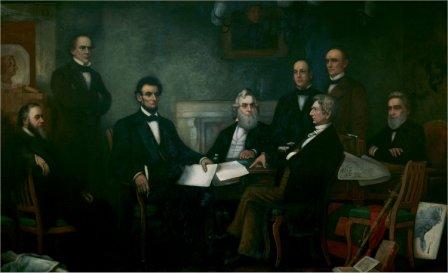Were all the slaves immediately free?
No. Only about 50,000 of the 4 million slaves were immediately set free. The Emancipation Proclamation had some limitations. First, it only freed the slaves in the Confederate States that were not under Union control. There were some areas and border states where slavery was still legal, but were part of the Union. The slaves in these states were not immediately freed. For the rest of the Southern states, the slaves would not be free until the Union was able to defeat the Confederacy.
However, the Emancipation Proclamation did eventually set millions of slaves free. It also made clear that in the near future all slaves should and would be set free.
The Emancipation also allowed for Black men to fight in the Union Army. Around 200,000 black soldiers fought on the side of the Union Army helping the North win the war and also helping to expand the area of freedom as they marched through the South.
Why did Lincoln wait until 1863?
 |
| Signing of the Emancipation Proclamation |
Lincoln felt like he needed a major victory in order to have the full support behind the Emancipation. If he issued the order without public support, it might fail and he wanted to be sure that it was successful and seen as a major moral victory for the North. When the Union Army turned back Robert E. Lee and the Confederates in the Battle of Antietam on September 17, 1862 Lincoln knew it was time. The initial announcement that the Emancipation Proclamation order was coming was given a few days later on September 22, 1862.
The Thirteenth Amendment
The Emancipation Proclamation was an executive order. It wasn't fully law per the Constitution yet. However, it did pave the way for the Thirteenth Amendment. The advantage of the Proclamation was that it could happen quickly. The Thirteenth Amendment took a few more years to get passed by congress and implemented, but on December 6, 1865 the Thirteenth Amendment was adopted and became part of the United States Constitution.
Here is the wording of the Thirteenth Amendment:
- Section 1. Neither slavery nor involuntary servitude, except as a punishment for crime whereof the party shall have been duly convicted, shall exist within the United States, or any place subject to their jurisdiction.
- Section 2. Congress shall have power to enforce this article by appropriate legislation
- The original document was five pages long. It is currently located in the National Archives in Washington D.C.
- The proclamation gained the Union the support of international countries such as Great Britain and France, where slavery had already been abolished.
- It did not free the slaves in the loyal border states. They would have to wait until the war was over.
- The order declared "that all persons held as slaves" within the rebel states "are, and henceforward shall be free."
| 1) Which of the following did the Emancipation Proclamation do? | |
| A | Freed all slaves in the Confederate states that were not currently under Union control. |
| B | Laid the groundwork for a future constitutional amendment to outlaw slavery. |
| C | Allowed for African American men to fight in the Union army. |
| D | All of the above |
2) How many slaves were immediately set free by the proclamation? | |
| A | All 4 million |
| B | Around half. |
| C | No slaves were set free. |
| D | 50,000 |
| E | 1,000 |
3) The Emancipation Proclamation paved the way for what constitutional amendment that outlawed slavery in the United States? | |
| A | The thirteenth amendment |
| B | The nineteenth amendment |
| C | The fifth amendment |
| D | The first amendment |
| E | The twenty-first amendment |
4) Which of the below statements best describes the Emancipation Proclamation? | |
| A | A change to the United States constitution allowing for all men to vote regardless of race. |
| B | A new law issued by congress that said slavery was illegal in the North. |
| C | An executive order from Abraham Lincoln that eventually led to the freedom of millions of slaves. |
| D | A speech given by Abraham Lincoln asking for the Civil War to end. |
| E | An order made by the Supreme Court saying that the Confederate states had the right to decide for themselves on slavery. |
5) About how many black soldiers fought in the Union army during the Civil War? | |
| A | 200,000 |
| B | 10,000 |
| C | 4 million |
| D | 50,000 |
| E | None |
No comments:
Post a Comment